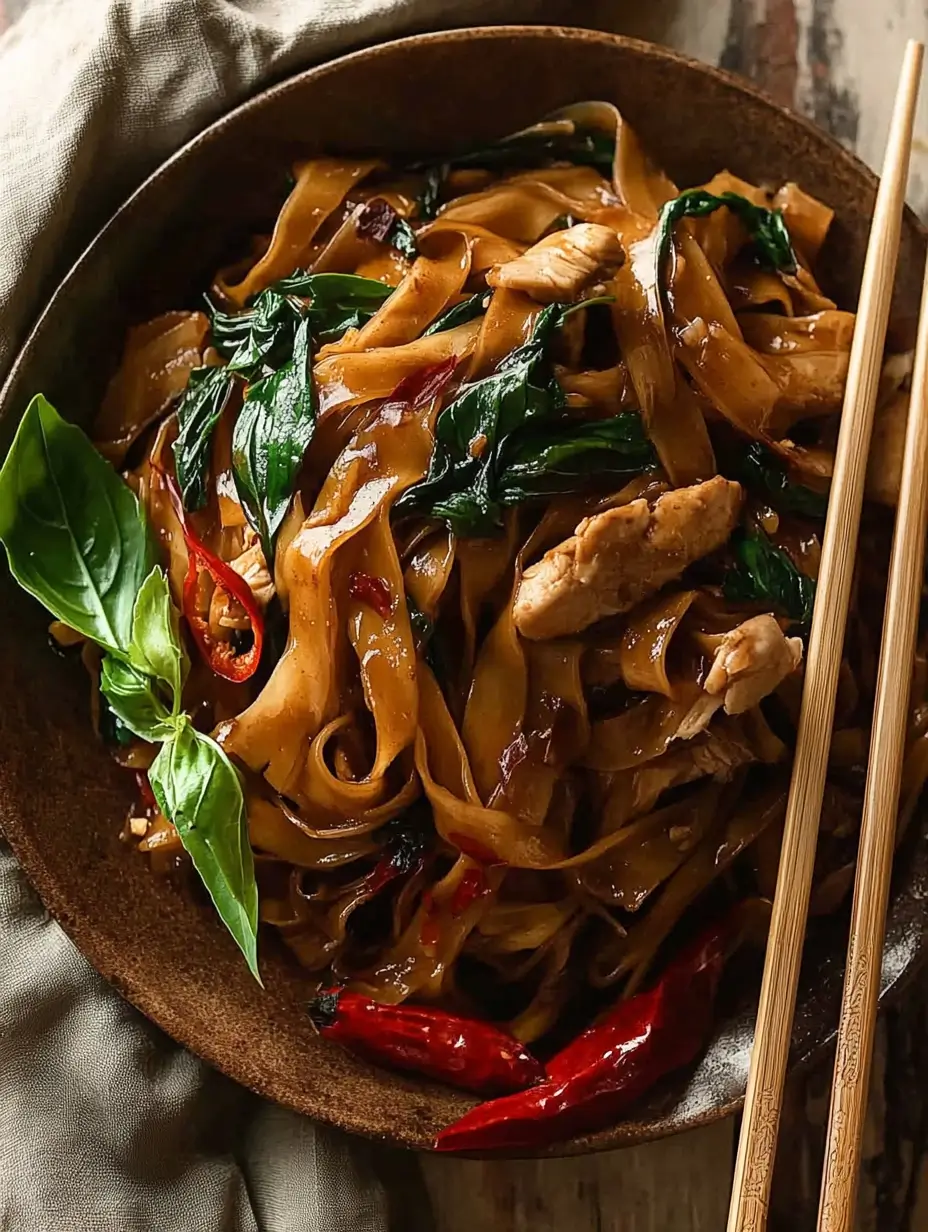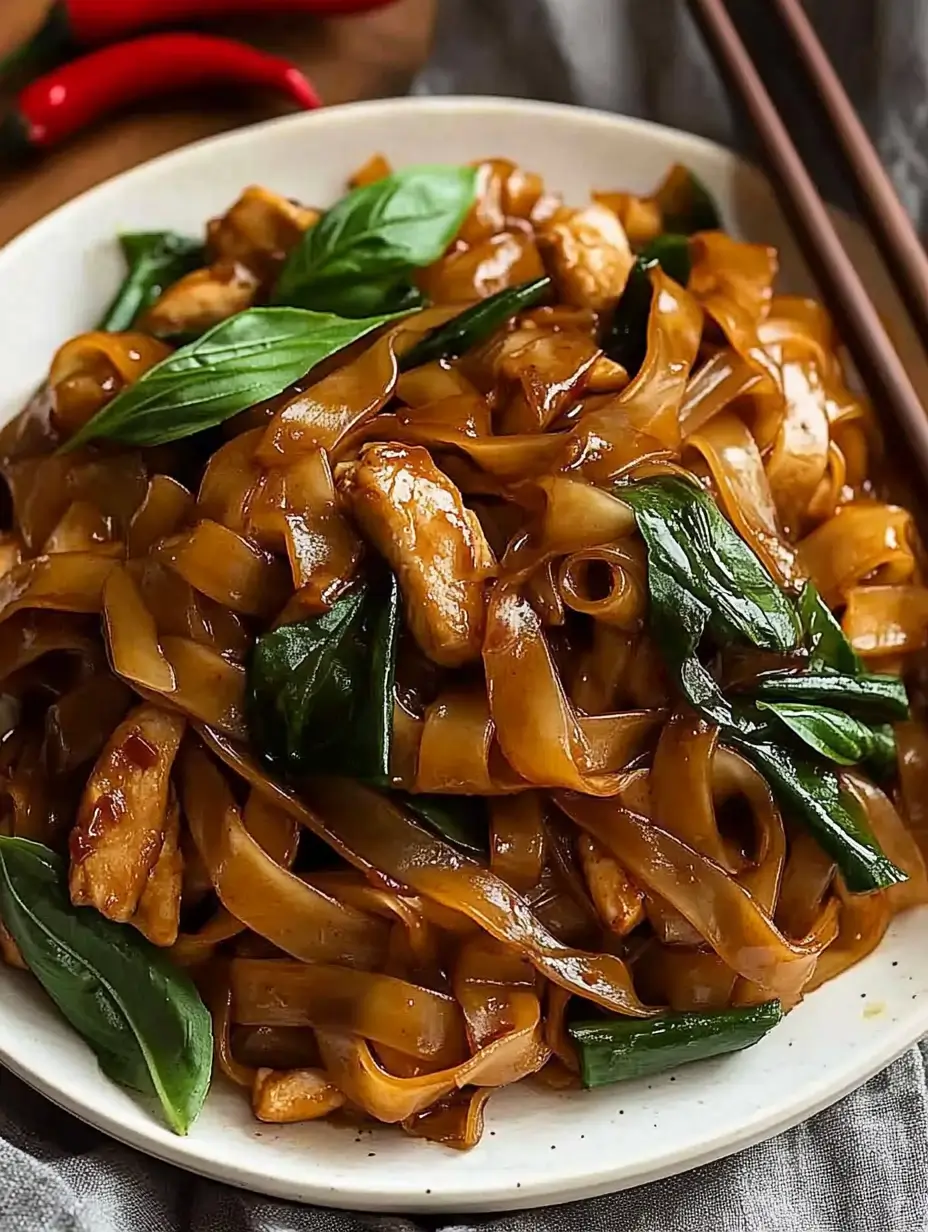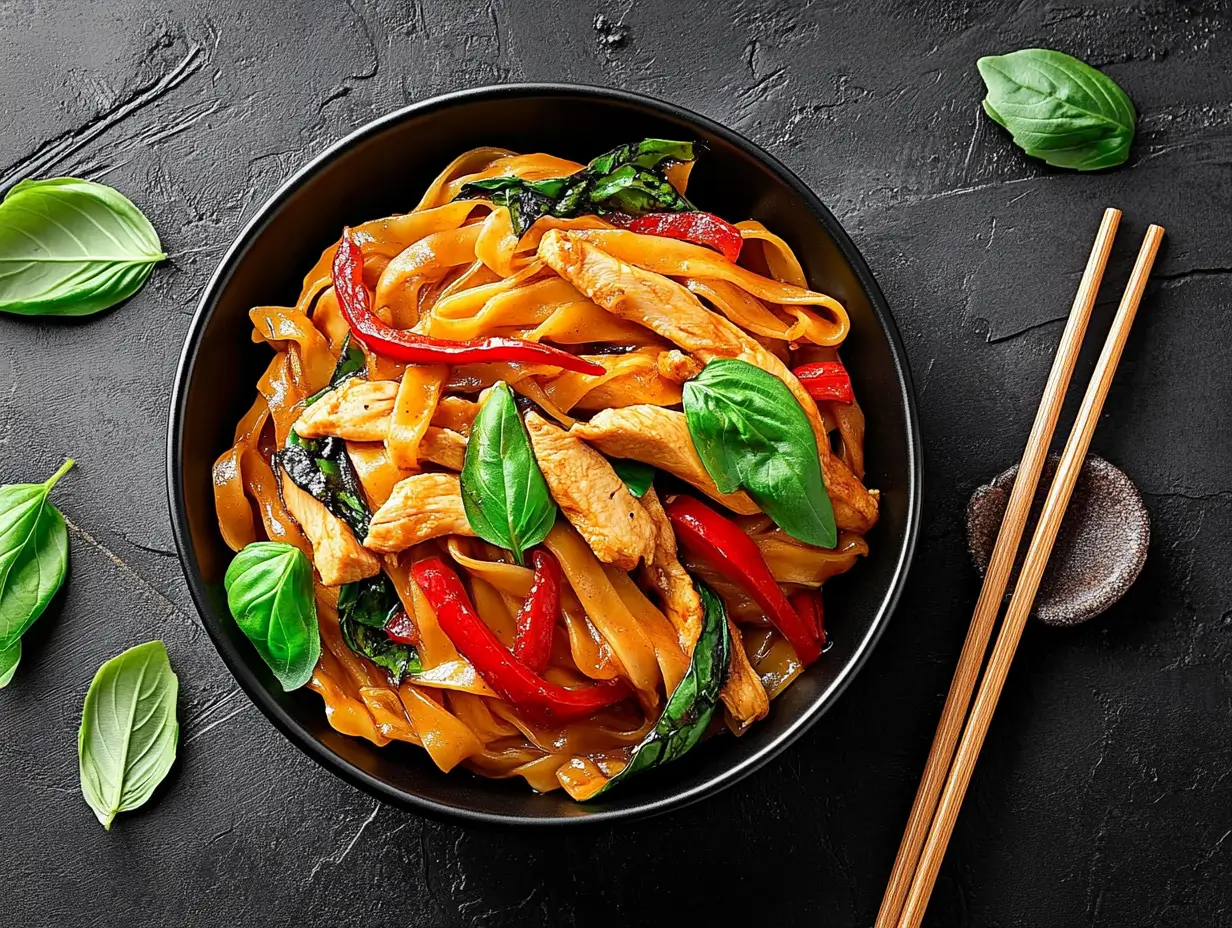Drunken noodles, the name quite funny, broadly known as Pad Kee Mao, are some of the things that have excited food lovers from various corners of the Earth. But what actually makes these noodles “drunken”? Anything to do with alcoholic spirit? Or does it have to do with the dish’s intense spiciness that almost leaves your taste buds in a stupor? This article dives into the origins, key ingredients, cooking techniques, and myths surrounding this iconic Thai dish. Along the way, we’ll uncover why Pad Kee Mao remains a beloved favorite globally and learn how to whip it up at home.
Introduction to Drunken Noodles
What Are Drunken Noodles?
Drunken noodles, known in Thailand as Pad Kee Mao, are a popular stir-fried noodle dish characterized by bold, spicy flavors and fragrant Thai basil. Despite the catchy name, these noodles don’t actually contain alcohol. Instead, they’re a delightful combination of wide rice noodles, vegetables, protein (often chicken, pork, or tofu), and a savory sauce with a hint of heat. A sprinkle of Thai basil crowns the dish, giving it its signature aroma.

Origins and Cultural Significance
It has one of those names that say Pad Kee Mao, which happens to be based on the myths that have origins in Thai cooking. One explanation for this mad dish is that the words directly combine with the intensity of the hotness and infer that drinking it with cold beer is best – the people who eat it late at night make up their whole fan club. Others claim it was created as a hangover cure—something to “wake you up” after a night of heavy drinking. Regardless of its beginnings, Pad Kee Mao has become a cornerstone of Thai street food culture, loved for its robust flavors and hearty appeal.
The Name Behind Drunken Noodles
Does It Contain Alcohol?
Does Pad Kee Mao have alcohol in it? The answer is no. This dish does not contain any alcoholic ingredients, despite having a name like that. So why do they call it drunk noodles. It is a kind of personal, almost intoxicating sensation created by an aggressive punch of flavors. Some suggest the dish is best enjoyed with a cold drink, like beer or whiskey, leading to the association with alcohol.
The Myth of Drunkenness
While the dish doesn’t have alcohol, it does have a reputation for its intense heat and flavors that can leave your palate reeling. This has led many to believe that the “drunken” name symbolizes the feeling it invokes—a spicy kick that’s hard to forget. Legend has it that late-night revelers stumbled into street food stalls in search of something flavorful enough to match their spirited moods. Pad Kee Mao fit the bill perfectly, with its spicy, aromatic, and satisfying ingredients.
Historical Anecdotes About the Name
Jokes with history about the cooking of Thailand pad Kee mao. One such legend goes that the original cook of the dish was so dipped that he threw almost everything into a pot, result: an unbelievable disaster but a very delicious dish. Another theory proposed that the name Pad Kee Mao is derived from the fact that the dish is so effective as a cure for hangover. Whatever are its true origins, the drunkenness of drunken noodles might simply be defined from the culture around it and the lively dining traditions that accompany them.
Key Ingredients and Flavor Profile
Core Ingredients of Drunken Noodles
A stir-yarn sweet wonder, drunken noodles depend on a few simply delectable ingredients. Their basics, wide rice noodles, are chewy and fill one’s stomach. Another main ingredient usually makes the base-the protein either be chicken, beef, shrimp, or tofu, making this dish versatile enough to suit anyone’s taste. Crunchy and colorful, the dish also features fresh vegetables like bell peppers, onions, and carrots. Of course, of all that, Pad Kee Mao is also made incomplete without Thai basil, giving its unique, slightly spicy aroma.
The Role of Spices and Sauces
The actual magic of Pad Kee Mao is in its sauce-a combination of soy sauce, oyster sauce, fish sauce, and a touch of sugar to balance all those flavors. But what makes the drunk noodles truly drunk are those fiery chilies. They give the dish high heat and make it bold and spicy. The sweet, savory, and spicy flavors guarantee that every bite gives you the full flavor experience.
How Ingredients Create a “Drunken” Effect
Nonetheless, the senses can overwhelm by the interplay of these bold ingredients-this might be the reason why people associate the dish with drunkenness. However, this thin layer memory is literally from the hot chilies, fresh burst Thai basil, and umami-rich sauce to create an indulgent layered complexity. There is no alcohol, but the rushing flavor makes one more like one has a wild culinary-like adventure.
Cooking Techniques That Define Drunken Noodles
Traditional Pad Kee Mao Cooking Method
Drunken noodles, also known as Pad Kee Mao, are best cooked in a very hot wok in order to get that very smoky, charred flavor. The process begins by heating oil to almost smoking point to stir-fry garlic and chilies. This method is only for a few seconds, using the flames of heat to release aromatic oils and create the flavor base of the dish. Thereafter, add your proteins and veg, followed by the same wide rice noodles and a huge splash of sauce. Stirring frequently helps the noodles absorb the sauce evenly, creating the dish’s signature bold taste.
Variations Across Thai Regions
Curiously, what makes drunken noodles drunk can vary according to which place you’re eating them: central Thailand, where the dish has an extra spicy kick, thanks to additional chilies and garlic; and southern Thai versions, which pepper in more seafood to reflect that coastal flavor. No matter what variation, there is never a compromise on the ingredient: Thai basil. This ties up the fiery and savory notes of the dish.
Tips for Achieving Authentic Taste
It is really easy to forge the true taste of Pad Kee Mao at home with a few tricks. First, use fresh Thai basil for optimum flavor. Second, make sure that the noodles are slightly under cooked before stir-frying so that they don’t break apart. Lastly, don’t shy away from using fish sauce—it’s a key ingredient that adds depth and umami. For more insight into the sauce that gives the dish its unique flavor, you can check out What Is Drunken Noodles Sauce Made Of?.

Popular Myths and Facts About Drunken Noodles
Why They’re Not Actually “Drunken”
A lingering myth about Pad Kee Mao is that it contains alcohol. However, as mentioned earlier, no booze is involved in this recipe. So, what makes drunken noodles drunk? Some say it’s the dish’s heat and bold flavors that leave diners feeling dazed and satisfied. Others argue the “drunken” aspect stems from its reputation as a late-night indulgence for party-goers.
Common Misconceptions About the Dish
Another common misunderstanding is that Pad Kee Mao is always unbearably spicy. While chilies play a significant role, the spice level can be adjusted to taste, making it accessible to a wider audience. It’s also worth noting that not all versions of drunken noodles feature meat—vegetarian and vegan variations are equally delicious and popular.
Insights From Thai Culinary Experts
Thai chefs often emphasize the balance of flavors in Pad Kee Mao. The dish isn’t just about heat—it’s the harmony between salty, sweet, and spicy that defines its charm. They also stress the importance of fresh ingredients, particularly Thai basil, as it’s what makes drunken noodles drunk in terms of flavor and aroma.
For another twist on this classic dish, consider exploring Italian Drunken Noodles Recipe, a fusion adaptation that adds unique flavors while maintaining the spirit of the original.
The Global Appeal of Drunken Noodles
Adaptations Outside Thailand
Drunken noodles, or Pad Kee Mao, have become a global favorite, with many restaurants and home cooks putting their unique spin on the dish. In the United States, for instance, you’ll often find a milder version with less heat to cater to broader palates. Some variations swap traditional Thai basil for sweet basil or add bell peppers and broccoli for extra crunch. Despite these changes, the heart of the dish—its bold, savory flavor—remains intact.
Why It Became Popular Worldwide
runken noodles are versatile with those lingering tastes, making them extremely popular. Salty, sweet, spicy, and downright umami, just perfect with Hollywood and foodies all at once. Moreover, their quick preparation time makes them a favorite at Thai street stalls and international restaurants alike. But what makes drunken noodles drunk in a global sense? It’s their ability to adapt to local tastes while still delivering a taste of authentic Thai cuisine.
Fusion Dishes Inspired by Drunken Noodles
The influence of Pad Kee Mao is evident in fusion dishes around the world. For example, Italian drunken noodles combine the spicy, saucy goodness of the original with wide pappardelle pasta. There are also vegan versions featuring plant-based proteins and gluten-free options using rice noodles. These creative adaptations highlight how this classic dish continues to evolve while staying true to its roots.
For more inspiration, check out the Italian Drunken Noodles Recipe for a delightful twist on the original.
Recipe Section: How to Make Authentic Drunken Noodles at Home
Ingredients List and Preparation
To make authentic Pad Kee Mao, you’ll need the following:
- Wide rice noodles (fresh or dried)
- Protein of your choice (chicken, pork, shrimp, or tofu)
- Vegetables like bell peppers, onions, and carrots
- Garlic and Thai chilies
- Thai basil leaves
- Soy sauce, fish sauce, oyster sauce, and a bit of sugar
Start by soaking dried rice noodles in warm water or boiling fresh noodles until tender but firm. Chop all vegetables and protein into bite-sized pieces for quick cooking.
Step-by-Step Cooking Instructions
- Heat oil in a wok over high heat until almost smoking.
- Stir-fry garlic and chilies until fragrant.
- Add your protein and cook until just done.
- Toss in the vegetables and stir-fry briefly.
- Add the noodles and pour in the sauce mixture.
- Stir-fry quickly, ensuring the noodles are evenly coated.
- Finish with fresh Thai basil leaves for a burst of flavor.
This simple process captures what makes drunken noodles drunk: the lively combination of spices, sauces, and fresh ingredients.
Tips for Customizing the Recipe
Tweak the spice quotient according to your taste. For instance, if you are a vegetarian, fish sauce and oyster sauce can be substituted with soy-based sauces. An extra kick of lime juice would also zing the flavor at the final stage. For more cooking ideas, visit What Is Drunken Noodles Sauce Made Of?.
FAQs: Common Questions About Drunken Noodles
Are Drunken Noodles Spicy?
Yes, Pad Kee Mao is traditionally a spicy dish, thanks to the inclusion of fresh Thai chilies. However, you can adjust the heat level based on your tolerance. For those who enjoy a milder flavor, reducing the chilies or replacing them with milder peppers is an easy fix. Still, the kick from the spices is often what makes drunken noodles drunk for many fans of this flavorful dish.
Can I Make Them Vegetarian or Vegan?
Absolutely! Drunken noodles are incredibly versatile and can easily be made vegetarian or vegan. Swap out fish sauce for soy sauce or other plant-based alternatives. You can also use tofu or tempeh instead of meat for a protein-packed, cruelty-free option. The result will still deliver the bold and satisfying flavors Pad Kee Mao is known for.
What Pairs Well With Drunken Noodles?
Drunken noodles pair wonderfully with light, refreshing sides like Thai cucumber salad or a simple green tea to balance their heat. Alternatively, they go well with crispy spring rolls or a tangy Thai mango salad for a complete meal that highlights the dish’s vibrant flavors.

